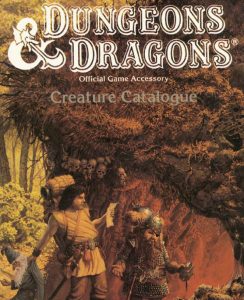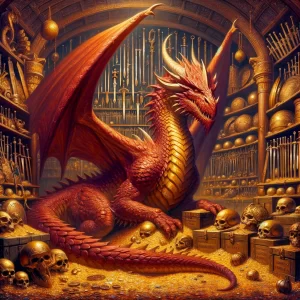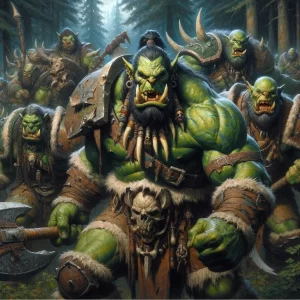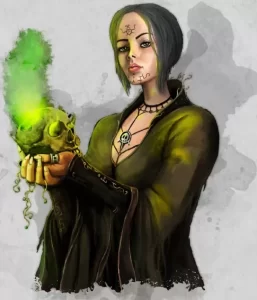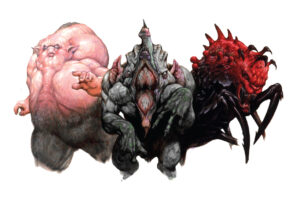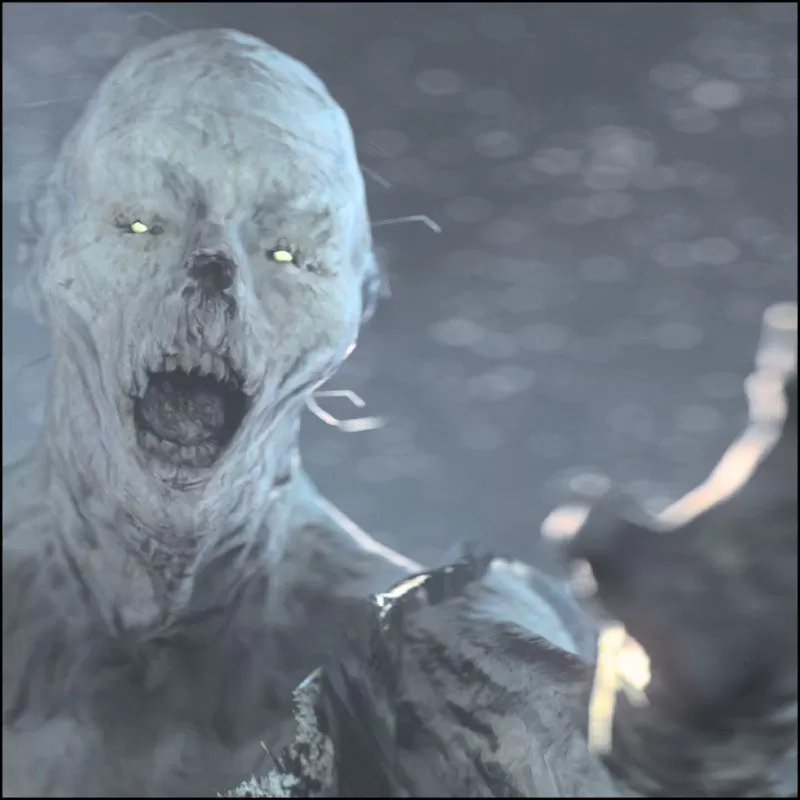
Ever voracious, ghouls stalk the catacombs, battlefields, and charnel heaps to feast on rotting flesh. Their physiology varies significantly but, on the whole, ghouls have pallid, translucent skin, with layers of muscle and bones glimpsed beneath, sometimes giving the impression of a corpse. Their fleshless limbs hold a deceptive, wiry strength, and their often-emaciated forms can swell considerably when gorged with flesh. Beyond these commonalities, individual ghouls can appear wildly different, as a result of their reproductive strategy, with some bearing fleshy wings, grotesquely hulking musculature, or even taking on a macabre semblance of human form.
Ghouls are reliant mostly on their sense of smell; they can pick up the scent of a carcass from miles away, and beneath several feet of earth. It is theorized they communicate to each other with pheromones; indeed, some use these pheromones as a natural weapon, producing a noxious odor which can incapacitate living creatures. However, most ghouls possess at least limited vision and, despite their hatred of the sun, those rare ghouls that are active during the day have been observed watching carrion birds in order to locate corpses. Despite common wisdom that suggests otherwise, ghouls are not harmed by sunlight; they simply prefer to forage under the cover of darkness.
Given a modest food source, a ghoul can be relatively benign, content to eat until the supply is exhausted before moving on to search for more. Being undead, they do not digest their meals in the usual sense, but the fermenting flesh aids in the development of larval ghouls. For this reason, if food is plentiful and they are allowed to gorge themselves, they become more of a threat, as their numbers swell. When plague and death stalk the land, ghouls are sure to follow, and the local populace learns quickly to burn their dead, or are overcome as the ghoul population expands.
Though ghouls are undoubtedly undead, they are not the raised forms of corpses. Instead, they might be more accurately described as an entirely different form of life. It has been suggested that ghouls originate from another plane entirely, one where such life is common, and they have been drawn to ours through the cracks between worlds by the promise of food. Regardless of their origins, upon arrival, they spread quickly and can overrun an area in little time, if an infestation is not checked.
Ghouls reproduce by implanting a larva into a host body. While rotting corpses are preferred, ghouls are not fussy about the exact nature of the host, and some have even been known to make use of their paralyzing abilities to keep a living victim sedate in their lair (such forethought on the ghoul's part is, thankfully, rare). The larval ghoul absorbs their nutrients passively, at first, but soon develops jaws and begins feeding in earnest. The feasting ghoul matures quickly and so, when a lot of easy prey becomes available at the same time (for instance, after a battle), the ghoul population can explode almost overnight.
A curious quirk of ghouls, presumably due to their other-worldly nature, is their ability to gradually take on the physical, and even mental, traits of creatures that they feed upon. Additionally, the creature that serves as host for an implanted larva further shapes the ghoul that emerges from what's left of their harvested remains.
Over generations, this can alter different strains of ghoul dramatically. Ghouls have a marked preference for humanoid flesh, explaining their overall humanoid forms, but some differ from the norm, having gestated within significantly larger corpses, or those with unusual features, such as wings. After many generations of intelligent hosts, ghoul behavior can become more complex (these more cunning ghouls are sometimes distinguished as 'ghasts'), and some achieve near-human levels of intelligence, even gaining the power of speech and controlling their lesser brethren's development by providing them with specific foodstuffs, in much the same way livestock are bred for specific tasks.
A common myth is that a creature who indulges in cannibalism will, over time, become a ghoul themself. While mostly apocryphal, it is possible that a creature consuming the flesh of its own kind, where a ghoul has also fed, could ingest an amount of the ghoul's saliva (and, thus, their mutagenic properties) in a sufficient enough amount to trigger a physiological change over time.
A Ghouls Environment
Ghouls gather where there is a ready supply of flesh, and are able to derive nutrition from any flesh, no matter how decayed, even gnawing at old bones, long bereft of meat. They are tolerant of other ghouls, and group together where there is ample food, but will wander their separate ways when the supply runs low.
Ghouls prefer the dark. When they find outdoor food supplies, they will den during the day in a nearby cave, or burrow, and emerge to feed at night. When they find, or drag, a source of food to a sheltered underground location, they will feed day and night, only stopping when threatened, out of food or, most worryingly, ready to implant larvae. A ghoul's lair is strewn with splinters of bone from its feeding, and may contain the paralyzed bodies of its victims (or what remains of them) if it is in good enough condition to breed.
Most commonly associated with graveyards, crypts, and mausoleums, ghouls can also be found wandering the wilds. Wandering ghouls must resort to hunting and eating fresh meat more often than their more sedentary kin, and some develop a taste for it.
Rumors have always existed of ghoul cities, with tales of towers of bones, and living beings relegated to livestock. While feasible, given the existence of intelligent ghouls, the first-hand reports are rare and jumbled; clearly coming from minds too disorganized to give a full report of their experiences, if they ever even happened. Rather than crafting settlements in our own world, it is entirely possible these tales come from glimpses of the ghouls' home plane which, assuming ghouls themselves are representative, would be enough to drive even the most ordered mind to madness.
Ghouls are unsophisticated, and driven almost entirely by their supernatural hunger, but most are, at least, as intelligent as dogs, and some significantly more so. While this might lead some to hope that a ghoul can be reasoned with, the truth is that, more often than not, this intelligence merely makes them more efficient hunters, less likely to fall for the simple traps which would, for example, outwit a zombie. Most ghouls are able to speak, to an extent, though commonly only know a few, disjointed words (such as 'hungry', 'food', or 'yummy').
Ghasts are of a more sophisticated bent, though feeding is still their main drive. A recently-fed ghast might have the foresight to allow a small amount of food to escape its clutches for the promise of greater reward later, a level of planning beyond most of its underlings.
